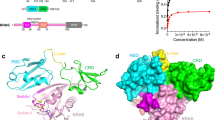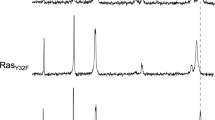Abstract
Binding of Ras to c-Raf-1 is a pivotal step of many mitogenic signalling pathways. Based on the recent crystal structure of the complex of Rap1 A with the Ras-binding domain of Raf, mutations were introduced in c-Raf-1 and their effects on Ras/Raf binding affinity in vitro and Ras/Raf regulated gene expression in vivo were analysed. Our data reveal an empirical semi-logarithmic correlation between dissociation constants and Raf-induced gene activity. The functional epitope that primarily determines binding affinity consists of residues Gin 66, Lys 84 and Arg 89 in Raf. This quantitative structure-activity investigation may provide a general approach to correlate structure-guided biochemical analysis with biological function of protein–protein interactions.
This is a preview of subscription content, access via your institution
Access options
Subscribe to this journal
Receive 12 print issues and online access
$189.00 per year
only $15.75 per issue
Buy this article
- Purchase on Springer Link
- Instant access to full article PDF
Prices may be subject to local taxes which are calculated during checkout
Similar content being viewed by others
References
Daum, G., Eisenmann-Tappe, I., Fries, H.W., Troppmair, J. & Rapp, U. The ins and outs of Raf kinases. Trends Biochem. Sci. 19, 474–480 (1994).
Koide, H., Satoh, T., Nakafuku, M. & Kaziro, Y. GTP-dependent association of Raf-1 with H-Ras: Identification of Raf as a target downstream of Ras in mammalian cells. Proc. Natl. Acad. Sci. USA 90, 8683–8686 (1993).
Moodie, S.A., Willumsen, B.M., Weber, M.J. & Wolfman, A. Complexes of Ras-GTP with Raf-1 and mitogen activated protein kinase kinase. Science 260, 1658–1661 (1993).
Van Aelst, L., Barr, M., Marcus, S., Polverino, A. & Wigler, M. Complex formation between Ras and Raf and other protein kinases. Proc. Natl. Acad. Sci. USA 90, 6213–6217 (1993).
Voijtek, A.B., Hollenberg, S.M. & Cooper, J.A. Mammalian Ras interacts directly with the serine/threonine kinase Raf. Cell 74, 205–214 (1993).
Warne, P.H., Rodriguez Viciana, P. & Downward, J. Direct interaction of Ras and the amino-terminal region of Raf-1 in vitro. Nature 364, 352–355 (1993).
Zhang, X.-f. et. al. Normal and oncogenic p21ras proteins bind to the amino-terminal regulatory domain of c-Raf-1. Nature 364, 308–313 (1993).
Wiesmüller, L. & Wittinghofer, A. Signal transduction pathways involving Ras. Cell. Signal. 6, 247–267 (1994).
Barbacid, M. ras genes. A. Rev. Biochem. 56, 779–827 (1987).
Bos, J.L. ras oncogenes in human cancer: a review. Cancer Res. 49, 4682–4689 (1989).
Chuang, E. et al. Critical binding and regulatory interactions between Ras and Raf occur through a small, stable N-terminal domain of Raf and specific Ras effector residues. Molec. Cell. Biol. 14, 5318–5325 (1994).
Emerson, S.D. et al. Chemical shift assignments and folding topology of the Ras-binding domain of human Raf-1 determined by heteronuclear three-dimensional NMR spectroscopy. Biochemistry 33, 7745–7752 (1994).
Fridman, M. et al. The minimal fragments of c-Raf-1 and NF-1 that can suppress v-Ha-Ras-induced malignant phenotype. J. Biol. Chem. 269, 30105–30108 (1994).
Scheffler, J.E. et al. Characterization of a 78-residue fragment of c-Raf-1 that comprises a minimal binding domain for the interaction with Ras-GTP. Biochemistry 35, 22340–22346 (1994).
Herrmann, C., Martin, G.A. & Wittinghofer, A. Quantitative analysis of the complex between p21ras and the Ras-binding domain of the human Raf-1 protein kinase. J. Biol. Chem. 270, 2901–2905 (1995).
Pawson, T. Protein modules and signalling networks. Nature 373, 573–580 (1995).
Bruder, J.T., Heidecker, G. & Rapp, U.R. Serum-, TPA-, and Ras-induced expression from Ap-1/Ets-driven promotors requires Raf-1 kinase. Genes Dev. 6, 545–556 (1992).
Troppmair, J. et al. Mitogen-activated protein kinase/Extracellular signal-regulated protein kinase activation by oncogenes, serum, and 12-O-tetradecanoylphorbol-13-acetate requires Raf and is necessary for transformation. J. Biol. Chem. 269, 7030–7035 (1994).
Leevers, S.J., Paterson, H.F. & Marshall, C.J. Requirement for Ras in Raf activation is overcome by targeting Raf to the plasma membrane. Nature 369, 411–414 (1994).
Stokoe, D., Macdonald, S.G., Cadwallader, K., Symons, M. & Hancock, J.F. Activation of Raf as a result of recruitment to the plasma membrane. Science 264, 1463–1467 (1994).
Marshall, M.S. The effector interactions of p21 ras. Trends Biochem. Sci. 18, 250–254 (1993).
Polakis, P. & McCormick, F. Structural requirements for the interaction of p21ras with GAP, exchange factors, and its biological effector targets. J. Biol. Chem. 268, 9157–9160 (1993).
Melnick, M.B., Perkins, L.A., Lee, M., Ambrosia, L. & Perrimon, N. Developmental and molecular characterization of mutations in the drosophila-raf serine/threonine kinase. Development 118, 127–138 (1993).
Fabian, J.R., Vojtek, A.B., Cooper, J.A. & Morrison, D.K. A single amino acid change in Raf-1 inhibits Ras binding and alters Raf-1 function. Proc Natl. Acad. Sci. U.S.A. 91, 5982–5986 (1994).
Dent, P., Jelinek, T., Morrison, D.K., Weber, M.J. & Sturgill, T.W. Reversal of Raf-1 activation by purified and membrane-associated protein phosphatases. Science 268 1902–1906 (1995).
Dent, P., Reardon, D.B., Morrison, D.K. & Sturgill, T.W. Regulation of Raf-1 and Raf-1 mutants by Ras-dependent and Ras independent mechanisms in vitro. Molec. Cell. Biol. 15, 4125–4135 (1995).
Marais, R., Light, Y., Paterson, H.F. & Marshall, C.J. Ras recruits Raf-1 to the plasma membrane for activation by tyrosine phosphorylation. EMBO J. 14, 3136–3145 (1995).
Seger, R. & Krebs, E.G. The MAPK signaling cascade. FASEB J. 9, 726–735 (1995).
Janknecht, R., Ernst, W.H., Pingoud, V. & Nordheim, A. Activation of ternary complex factor Elk-1 by MAP kinases. EMBO J. 12, 5097–5104 (1993).
Marais, R., Wynne, J. & Treisman, R. The SRF accessory protein Elk-1 contains a growth factor-regulated transcriptional activation domain. Cell 73, 381–393 (1993).
Janknecht, R., Cahill, M.A. & Nordheim, A. Signal integration at the c-fos promoter. Carcinogenesis 16, 443–450 (1995).
Nassar, N., Horn, G., Herrmann, C., Scherer, A., McCormick, F. & Wittinghofer, A. The 2.2Å crystal structure of the Ras-binding domain of the serine/threonine kinase c-Raf 1 in complex with Rap1A and a GTP analogue. Nature 375, 554–560 (1995).
Pai, E.F., Kabsch, W., Krengel, U., Holmes, K.C., John, J. & Wittinghofer, A. Structure of the guanine-nudeotide-binding domain of the Ha-ras oncogene product p21 in thetriphosphate conformation. Nature 341, 209–214 (1989).
Kitayama, H., Sugimoto, Y., Matsuzaki, T., Ikawa, Y. & Noda, M. A ras-related gene with transformation suppressor activity. Cell 56, 77–84 (1989).
Zhang, K., Noda, M., Vass, W.C., Papageorge, A.G. & Lowy, D.R. Identification of divergent amino acids that mediate the opposing effects of ras and Krev-1. Science 249, 162–165 (1990).
Marshall, M.S. et al. Identification of amino acid residues required for Ras p21 ras target activation. Molec. Cell. Biol. 8, 3997–4004 (1991).
Clackson, T. & Wells, J.A. A hot spot of binding energy in a hormone-receptor interface. Science 267, 383–386 (1995).
Gibbs, J.B. & Olif, A. Pharmaceutical research in oncology. Cell 79, 193–198 (1994).
Emerson, S.D. et al. Solution structure of the Ras-binding domain of c-Raf-1 and identification of its Ras interaction surface. Biochemistry 34, 6911–6918 (1995).
Barnard, D. et al. Identification of the sites of interaction between c-Raf-1 and Ras-GTP. Oncogene 10, 1283–1290 (1995).
Cunningham, B.C. & Wells, J.A. Comparison of a structural and a functional epitope. J. Molec. Biol. 234, 554–563 (1993).
Jin, L., Fendly, B.M. & Wells, J.A. High resolution functional analysis of antibody-antigen interactions. J. Molec. Biol. 226, 851–865 (1992).
Kelley, R.F. & O'Connel, M.P. Thermodynamic analysis of an antibody functional epitope. Biochemistry 32, 6828–6835 (1993).
Cunningham, B.C. & Wells, J.A. Rational design of receptor-specific variants of human growth hormone. Proc Natl. Acad. Sci. U.S.A. 88, 3407–3411 (1991).
Brtva, T.R. et al. Two distinct Raf domains mediate interaction with Ras. J. Biol. Chem. 270, 9809–9812 (1995).
anknecht, R. & Nordheim, A. Gene regulation by Ets proteins. Biochim. Biophys. Acta 1155, 46–356 (1993).
Wittinghofer, A. & Herrmann, C. Ras-effeetor interactions, the problem of specificity. FEBS Lett. 369, 52–56 (1995).
Block, C. & Wittinghofer, A. Switching to Rac and Rho. Structure 3, 1281–1284 (1995).
John, J., Frech, M. & Wittinghofer, A. Biochemical properties of Ha-ras encoded p21 mutants and mechanism of the autophosphorylation reaction. J. Biol. Chem. 263, 11792–11799 (1988).
Barettino, D., Feigenbutz, M., Valcàrel, R. & Stunnenberg, H.G. Improved method for PCR-mediated site-directed mutagenesis. Nucl. Acids Res. 22, 541–542 (1994).
Meloche, S., Pagès, G. & Pouysségur, J. Functional expression and growth factor activation of an epitope-tagged p44 mitogen activated protein kinase, p44mapk. Molec. Biol. Cell 3, 63–71 (1992).
Author information
Authors and Affiliations
Rights and permissions
About this article
Cite this article
Block, C., Janknecht, R., Herrmann, C. et al. Quantitative structure-activity analysis correlating Ras/Raf interaction in vitro to Raf activation in vivo. Nat Struct Mol Biol 3, 244–251 (1996). https://doi.org/10.1038/nsb0396-244
Received:
Accepted:
Issue Date:
DOI: https://doi.org/10.1038/nsb0396-244



